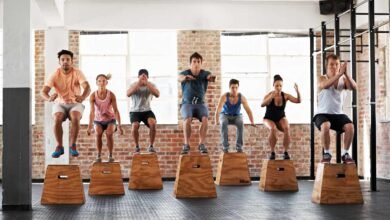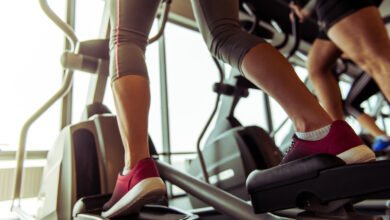How to Play Pickleball: Tips For Getting Started

Pickleball is a paddle sport that combines elements of ping pong, tennis, and badminton. The sport can be played on pickleball courts either indoors or outdoors.
While it was originally developed in the U.S. for children, pickleball is now enjoyed by people of all ages all over the world. Para-pickleball is also available for those who use a wheelchair. According to at least one study, pickleball is the fastest-growing sport in the U.S.
What Is Pickleball?
In 1965, three dads (all residents of Bainbridge Island, Washington) developed pickleball as a backyard game to entertain their children who had gotten bored with other activities. There are some reports that the sport was named after “Pickles” a dog owned by one of the creators. Although others say that the name actually came from the diverse nature of pickle boat rowing crews.
The sport has evolved over the years to include specialized equipment and playing spaces. In 1976, the sport was recognized by Tennis magazine and now there are tournaments and organizations located worldwide. The sport is also a common activity in school physical education programs.
Pickleball is most commonly played as a doubles sport (involving two teams of two people each) but it can also be played as a singles sport (one player versus one player). The social nature of the sport has made it exceptionally popular in senior communities.
Gear and Clothing
There are companies that sell pickleball-specific clothing, but you don’t have to buy special clothes to play the sport. The climate and conditions (indoor or out) will determine the best pickleball outfit. Moisture-wicking shorts, skorts, or pants can be worn with a tank or t-shirt and jacket if needed. If you’re playing outside, you may also want a visor and sport sunglasses to protect your eyes.
You will need to have court-friendly shoes that provide lateral support—such as tennis shoes. Shoes made for walking or running generally do not provide the kind of side-to-side support needed for pickleball.
You’ll also need to find the right kind of court, a ball, the rackets, and the net. When you’re first starting out, you can play pickleball with supplies you have on hand, that you rent, or that you pick up at a local sporting goods store. But the USA Pickleball Association (USAPA) also provides guidelines for approved courts, nets, paddles, and balls. There are vendors widely available that sell specific pickleball supplies.
Court
A pickleball court is smaller than a tennis court and most closely resembles a doubles badminton court. It is a rectangle measuring 20 feet by 44 feet. The net is placed across the center of the court, with a 7 foot non-volley zone on either side of the net (called the “kitchen”). The area behind the non-volley zone is divided between right and left service areas.
If you don’t have access to a pickleball-specific court, you can simply use a tennis court or another outdoor space and mark lines with chalk or colored masking tape. USA Pickleball provides specific instructions for marking a do-it-yourself pickleball court.
Net
A pickleball net measures at least 21 feet and 9 inches across and it should be at least 30 inches high. It should be made out of a mesh fabric with a white tape binding at the top. It should measure 36 inches high at the sidelines and 34 inches in the middle.
Balls
There are different types of pickleball, but in general, they look somewhat like a whiffle ball. They are made of seamless, molded, plastic and have holes of varying sizes. The balls might be yellow, black, blue, or multicolor.
Outdoor balls are usually heavier, harder, smoother, and have smaller holes (about 40 holes) so they come at the paddle faster.
Indoor balls are lighter, softer, and have fewer holes (about 26 holes). Outdoor and indoor balls are not used interchangeably.
Paddles
Pickleball paddles look somewhat like ping pong paddles. Early pickleball paddles were made out of plywood, but paddles today have gone high tech. They can be made out of a variety of materials including wood, polymer, or aluminum. The paddle face can be made out of carbon fiber, fiberglass, or graphite.
To find the best paddle for you, find one that fits your grip and has a good feel in your hand.
A medium-weight paddle will weigh about 7.3 to 8.4 ounces but there are also heavier paddles and lightweight paddles.
Heavier paddles provide more power, but lightweight paddles provide more control.
Pickleball Rules
Like other similar sports (like ping pong, badminton, and tennis) the object of pickleball is to score points by lobbing a ball over the net so that your opponent cannot return it.
You can also score points if your opponent volleys in the non-volley zone or hits the ball out of bounds. Players take turns serving the ball and you can only earn points if you or your team is serving.
The first team or player to reach 11 points with a two-point advantage wins the game. If you reach a score of 11 without a 2-point advantage the game continues until one side reaches it. Pickleball never ends in a tie.
Rules for pickleball are outlined in detail by USA Pickleball. The basic guidelines are usually referred to as “The Five Rules” but the rules of play are more extensive than five simple guidelines.
General Pickleball Rules
A very general outline of the five basic rules is as follows:
- You can’t hit the ball out of bounds.
- The ball must be served underhand and below the waistline.
- After a serve, the ball must bounce once on the other side before returning and then once again on the serving side. This is known as the two-bounce rule. After the two bounces, players may volley the ball.
- A ball can’t touch the no-volley zone on a serve.
- A pickleball game ends at 11, 15, or 21 points. Usually, the game ends at 11 points, but 15 and 21 are also common endpoints.
Tournaments and Organizations
If you try the sport and decide that you want to get more involved, there are a number of organizations that provide resources regarding equipment, game rules, and tournaments.
You are also likely to find local organizations by searching social media or the web.
Health Benefits
Like all types of physical exercise, pickleball helps you to burn calories and stay in shape. Exercise can also provide benefits including better sleep, improved energy, and a reduced risk of certain diseases such as type 2 diabetes, arthritis, heart disease, and stroke.
With the surge in the popularity of pickleball, there have been some studies investigating the specific health benefits of the sport.
Burns Calories
The number of calories you burn playing pickle ball can vary substantially based on a number of factors including your age and the intensity with which you play.
Most activity-based calorie calculators don’t include a category for pickleball, but you might estimate that it provides a workout similar to ping pong or tennis.
Based on estimates for other sports, a 150-pound person might burn between 286 (table tennis) and 500 calories (tennis) during a one-hour game of pickleball.
To estimate the number of calories that you might burn, use this calorie calculator.
Improved Cardiorespiratory Health
A very small study conducted at the University of Western Colorado and published in the International Journal of Research in Exercise Physiology involved just 15 older men and women who were tested before and after a pickleball intervention.
Researchers found that participants who played pickleball three times a week for one hour over a span of six weeks showed improved blood pressure, improved cholesterol levels, and better cardiorespiratory fitness when compared to baseline.
Improved Well-Being
Another small study published in 2017 discussed the benefits of pickleball for older adults. Study authors explored the characteristics of 153 older adult pickleball players, including lifestyles and psychosocial benefits.
The research findings suggested that pickleball is suitable for older women who feel lonely or in need of extended friendships through exercise, and also recommended for older adults who are searching for a productive and fruitful retirement. Study authors concluded that the sport “contributes to the well-being of older adults.”
Tips to Get Started
As with any new sport, it is important to make sure you are in good health before starting a program of physical activity. If you are managing any medical condition, if you are recovering from an injury, or if you have been sedentary for some time, check with your healthcare provider before starting to play.
Experts advise that if you have a functionally-limiting musculoskeletal problem (such as severe osteoarthritis), you should be cautious when starting to play, given the hard surface and recurrent impact with quick steps and rapid starting and stopping.
Also, there is no need to invest in expensive equipment to give the sport a try. There are many local organizations where you can rent a court and many even rent out equipment.
Once you learn the basics of the game, then seek out a local pickleball organization to learn more about the nuances of the game before you invest in equipment.
Like every other sport, pickleball injuries can happen. A published study suggested that injuries are most likely to be sprains or strains of the lower extremity, followed by sprains or strains of the upper extremity and injuries of the trunk and low back. Study authors also note that injuries can result from falls after a sudden turning or pivoting movement.
To decrease your risk of injury, be sure that you are warmed up before starting a game of pickleball. Walk briskly or jog for at least five minutes before starting to play.
Also, be sure that you have proper footwear and eye protection. Experts also advise that regular cardiovascular exercise outside of pickleball can help limit fatigue associated with play.




